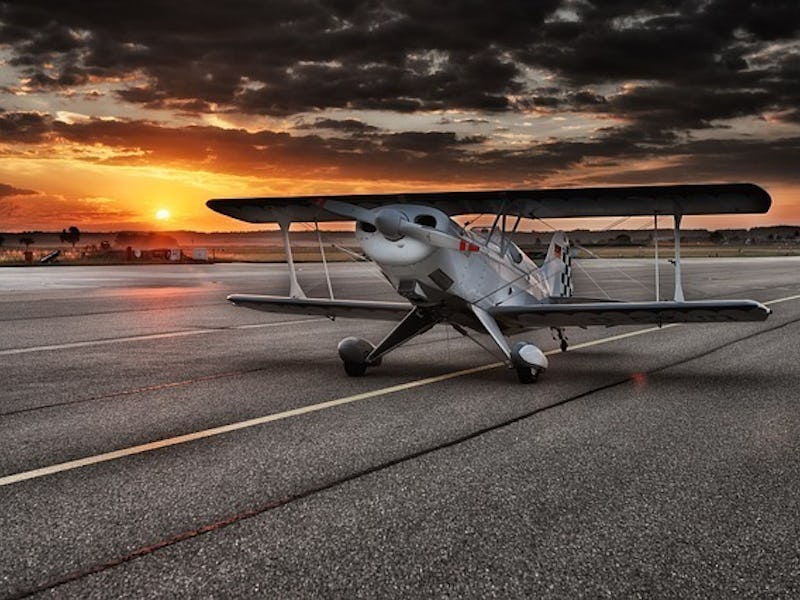ALTERNATE FUTURES | Gernsback's Rooftop Runways
In 1925, Hugo Gernsback predicted we'd be landing planes on the tops of buildings by 1975. Why aren't we?

“The tops of our tallest buildings will be flat and glass-covered. They will have airplane landing platforms on which all kinds of airplanes, or even the trans-Atlantic planes of the future will land.” - Hugo Gernsback, 1925
In 1925, Hugo Gernsback wrote a piece titled “Fifty Years From Now” for the San Antonio Light. In it, he laid out predictions for 1975. Some were startlingly close to the mark. Others … not so much.
Known as “The Father of Science Fiction,” one of Gernsback’s favorite arenas for making predictions was in transportation. He predicted moving sidewalks, electric skates, and teleportation, but one idea he came back to several times was air travel. Convinced that airplanes were going to fundamentally alter the way we lived, built, and treated distance, he was fascinated by air travel.
In some ways, he was right in his predictions. Air travel did change a lot about the way we travel, the way we move goods, and the way we view “remote” locations. When it came to this particular prediction regarding landing “platforms” on top of buildings, though, Gernsback was so close and yet so far from the mark.
First, some context: In 1925, planes were damn exciting. It was still early in the game, but they were showing promise. They were already being used to transport people and things, and less than two years after Gernsback wrote “Fifty Years From Now,” Charles Lindbergh would make his historic flight from New York to Paris.
Lindbergh
It’s also important to understand when Gernsback was making his predictions, cars didn’t hold the same place in the world that they do now. They weren’t a ubiquity yet. So, if you were to look at two immature (but promising) methods of transportation, airplanes were far and away the sexier option. It’s no real surprise Gernsback favored them when compared to cars. Is there any self-respecting sci-fi author who’d take four tires on the ground over a damned flying machine?
As with most of the predictions we look at, Gernsback was living in a time of incredible progress with regards to the subject on which he was writing. Given the incredible rate of advancement in air travel in the early 20th century, it wasn’t unreasonable to think we’d perfect the science of airplanes so completely that they’d be able to take off and land in small areas — perhaps on top of buildings.
But that’s not really how it works. To be clear, Gernsback was sort of close in the sense that we do have take-off and landing pads on the tops of our buildings, but they’re not for transatlantic aircraft. They are, of course, for helicopters. At least for now.
To state the obvious, helicopters are not typically intended for transatlantic flight. Has it been done, though? Yep. And actually, it was a little ahead of Gernsback’s mark — in 1967.
Technically, Gernsback was right about the “landing platforms” or helipads. He got the transatlantic part right, too. What he didn’t get right was the plane part.
Sure, maybe it’s a little nitpicky, but helicopters aren’t planes. The first helicopter didn’t fly until 1933, eight years after Gernsback wrote this piece. What’s more, though helicopters are also flying machines and some of them are capable of transatlantic flight, they’re probably not what Gernsback had in mind. For all practical purposes, he was talking about proper planes — you know, the kind with two wings … and it’s those wings that are the problem. Planes are a fundamentally different beast that still need a considerable amount of room for takeoffs and landings.
Planes work like this: A plane gets going really fast, which moves air over the wings faster than it moves under them, creating lift. It’s a simple concept that has everything to do with the shape of the wings, and speed is a key factor. Because of this, it means they need a big ol’ runway.
Now, to be fair to Gernsback, there are vertical takeoff and landing (VTOL) planes. But they’re not exactly landing on every helipad in Manhattan, and that definitely wasn’t the case in 1975. VTOL planes aren’t the type of aircraft that your average pilot can just hop in and control. Planes like the Harrier Jump Jet and the Marines’ Osprey are VTOL vehicles, but they’re extremely specialized.
Furthermore, there are experimental VTOL planes. It’s not as if plane innovation has stopped, but to be clear, these are probably a far cry from what Gernsback had in mind, and even in 2016, we’re not landing these things on buildings.
Maybe if Gernsback had known about the capabilities of helicopters, he would’ve been closer to the mark. Maybe if he’d adjusted his expectations even slightly, talking about short runways instead of the tops of buildings, he could’ve been a little more right. Maybe in an alternate future.